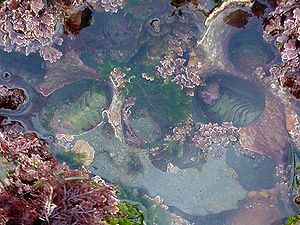Mesozoic marine revolution


The Mesozoic marine revolution (MMR) refers to the increase in shell-crushing (
The Mesozoic marine revolution was not the first bout of increased predation
Causes
The Mesozoic marine revolution was driven by the evolution of shell-crushing behaviour among Mesozoic marine predators, the technique being perfected in the Late Cretaceous. This forced shelled marine invertebrates to develop
It is thought that the break-up of Pangaea and the formation of new oceans throughout the Mesozoic brought together previously isolated marine communities, forcing them to compete and adapt. The increased shelf space caused by sea-level rise and a hyper-greenhouse climate provided more iterations and chances to evolve, resulting in increasing diversity.[2]
The evolution of angiosperms in the Cretaceous enhanced the hydrological cycling, speeding up rates of weathering and nutrient flow into the oceans, which has been cited as a possible driver of the MMR.[15]
Another proposal is the evolution of
Effects
The net result of the Mesozoic marine revolution was a change from the sedentary
Three major trends can be associated with this:[17]
- Reduction in suspension feeding epifauna[17]
- Increasing abundance of infauna[17]
- An intermediate stage of mobile epifauna.[17][18]
Major casualties of the Mesozoic marine revolution include:
Affected taxa
Gastropods
Benthic gastropods were heavily preyed upon throughout the Mesozoic Marine Revolution, the weaker shelled types being pushed out of the benthic zone into more isolated habitats. The Palaeozoic archaeogastropods were subsequently replaced by neritaceans, mesogastropods and neogastropods.[2] The former typically have symmetrical, umbilicate shells that are mechanically weaker than the latter. These lack an umbilicus and also developed the ability to modify the interior of their shells, allowing them to develop sculptures on their exterior to act as defence against predators.[2]
Another development among Muricidae was the ability to bore through shells and consume prey. These marks (while relatively rare) generally occur on sessile invertebrates, implying that they put pressure on Palaeozoic-type faunas during the Mesozoic Marine Revolution.[19]
Crinoids
The Mesozoic Marine Revolution heavily affected the crinoids, making the majority of their forms extinct. Their sessile nature made them easy prey for durophagous predators since the Triassic.
The shift in the range of sessile stalked crinoids during the late Mesozoic from the shallow shelf to habitats further offshore suggests that they were forced by increased predation pressure in shallow water to migrate to a deep water refuge environment where predation pressure was lower and their mode of life more viable.
Brachiopods
Brachiopods, the dominant benthic organism of the Palaeozoic, suffered badly during the Mesozoic Marine Revolution. Their sessile foot-attached nature made them easy prey to durophagous predators.[2] The fact that they could not re-attach to a substrate if an attack failed meant their chances of survival were slim. Unlike bivalves, brachiopods never adapted to an infaunal habit (excluding lingulids) and so remained vulnerable throughout the Mesozoic Marine Revolution. As a result of increased predation pressure on top of heightened competition with bivalves, brachiopods became a minor component of most marine faunas by the Cenozoic despite their incredible diversity and abundance during the Palaeozoic and early Mesozoic.[22]
Bivalves
Bivalves adapted more readily than the brachiopods to this ecological transition. Many bivalves adopted an infaunal habit, using their siphons to gather nutrients from the sediment-water interface while remaining safe.[2][5] Corbulids developed layers of conchiolin within their shells to better resist predation.[23] Others still, like Pecten, developed the ability to jump a short distance away from predators by contracting their valves.
Like brachiopods, epifaunal varieties of bivalves were preyed upon heavily. Among epifaunal types (such as
Echinoids
See also
- Cretaceous crab revolution
- Carboniferous-Earliest Permian Biodiversification Event
References
- PMID 18457902. Retrieved 4 April 2023.
- ^ S2CID 54742050.
- S2CID 83713101.
- ^ Stanley, S. M. (1974). "What has happened to the articulate brachiopods?". GSA Abstracts with Programs. 8: 966–967.
- ^ doi:10.1130/g33750.1.
- .
- S2CID 88004603. Retrieved 9 December 2022.
- S2CID 226298575. Retrieved 7 January 2023.
- ^ .
- .
- .
- ^ PMID 20231453.
- ISSN 0094-8373. Retrieved 16 September 2023.
- ISSN 1089-3326. Retrieved 16 September 2023.
- S2CID 53525330. Retrieved 16 September 2023.
- S2CID 55548554. Retrieved 16 September 2023.
- ^ S2CID 130270634.
- S2CID 83545582. Retrieved 16 September 2023.
- JSTOR 3515323.
- S2CID 86870809.
- PMID 30271929.
- .
- S2CID 234798442. Retrieved 16 September 2023.
- .
